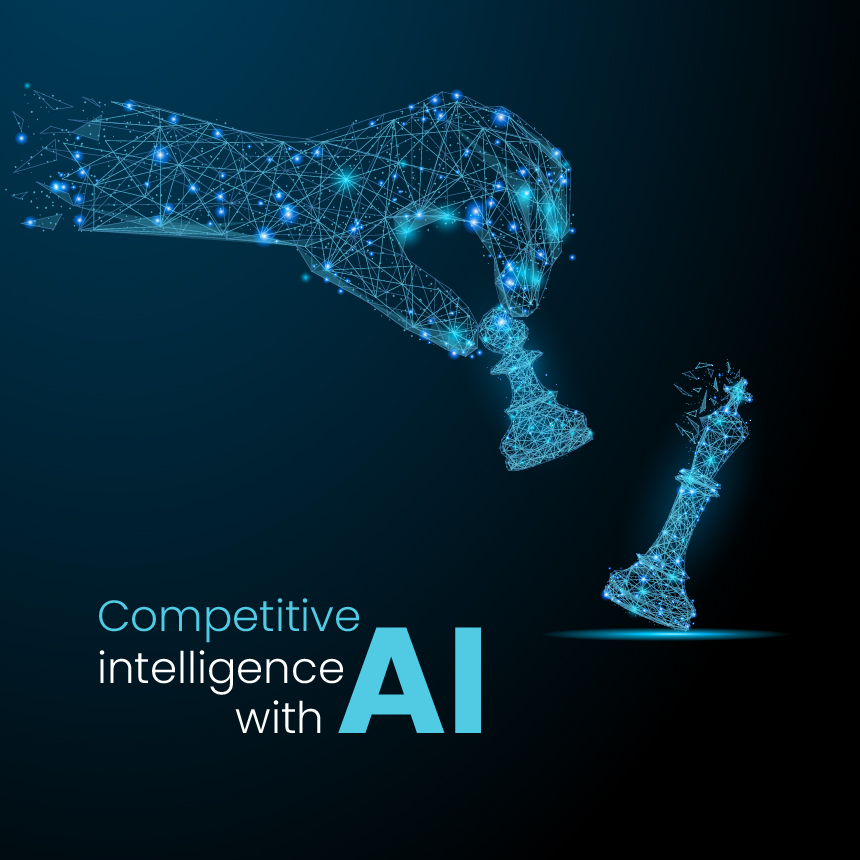Artificial Intelligence (AI) has revolutionized the way businesses operate, and one area where its impact is particularly profound is competitive analysis. In today’s dynamic business environment, staying ahead of the competition requires more than traditional methods. This article explores the role of AI in competitive analysis, shedding light on its evolution, applications, tools, challenges, success stories, future trends, and practical implementation for businesses of all sizes.
AI in Competitive Analysis

In a world driven by data, the integration of AI in competitive analysis has become a game-changer for businesses seeking a competitive edge. As we delve into the intricacies of AI, it’s crucial to understand its significance in deciphering and predicting the moves of competitors.
The Evolution of Competitive Analysis
1. Traditional methods vs. AI-driven analysis
Traditionally, businesses relied on manual methods for competitive analysis, often leading to delayed insights and limited scope. AI, however, has transformed this landscape, providing real-time, data-driven analysis that empowers businesses to make informed decisions swiftly.
2. Advantages of AI in analyzing competitors
AI brings efficiency and accuracy to the forefront, enabling businesses to analyze vast datasets and identify patterns that human analysis might overlook. The evolution from manual to AI-driven analysis signifies a paradigm shift in the way we understand and respond to competitive dynamics.
Applications of AI in Competitive Analysis
1. Market trend analysis
AI excels in processing large datasets to identify market trends, offering businesses a comprehensive understanding of industry shifts. This empowers decision-makers to adapt strategies in response to changing market dynamics.
2. Competitor behavior prediction
Through machine learning algorithms, AI can predict competitor behavior based on historical data. This foresight allows businesses to proactively position themselves, anticipating and countering competitors’ moves.
3. Pricing strategy optimization
AI-driven analysis provides insights into optimal pricing strategies by considering competitor pricing, market demand, and consumer behavior. This results in competitive pricing structures that enhance market share.
AI Competitive Analysis Tools
1. Machine Learning algorithms
Machine Learning algorithms are the backbone of AI-driven competitive analysis. These algorithms process vast amounts of data, learning and adapting to patterns, ultimately providing valuable insights for strategic decision-making.
2. Natural Language Processing (NLP) tools
NLP tools enable businesses to analyze unstructured data, such as customer reviews and social media sentiment. This allows for a more holistic understanding of competitors’ reputations and customer perceptions.
3. Predictive analytics in competitive intelligence
Predictive analytics leverages AI to forecast future market trends and competitor strategies. By harnessing predictive analytics, businesses can position themselves ahead of emerging trends, gaining a competitive advantage.
Enhanced Decision-Making with AI
1. Real-time data analysis
AI facilitates real-time analysis of data, ensuring that decision-makers have access to the most current information. This agility is crucial in a fast-paced business environment where timely decisions can make or break success.
2. Predictive modeling for strategic planning
By leveraging predictive modeling, businesses can simulate various scenarios, allowing for strategic planning based on probable outcomes. This forward-looking approach enhances decision-making by reducing uncertainty.
Challenges and Considerations
1. Data security and privacy concerns
The widespread use of AI in competitive analysis raises concerns about the security and privacy of sensitive data. Businesses must implement robust security measures to safeguard proprietary information and comply with data protection regulations.
2. The need for skilled professionals
While AI offers transformative capabilities, its effective implementation requires skilled professionals who can navigate and interpret complex algorithms. Investing in training and recruitment is essential for maximizing the benefits of competitive analysis.
Future Trends
1. Continuous advancements in AI technology
The field of AI is ever-evolving, with continuous advancements enhancing its capabilities. Future trends in competitive analysis include improved algorithms, enhanced data processing capabilities, and greater integration with other technological advancements.
2. Integration of AI with other emerging technologies
AI is increasingly being integrated with other emerging technologies, such as blockchain and the Internet of Things (IoT). This convergence expands the scope of competitive analysis, providing a more comprehensive understanding of market dynamics.
3. Predictions for the future landscape
As AI continues to evolve, the future landscape of competitive analysis will likely see an increased reliance on AI for decision support. Businesses that embrace and adapt to these technological shifts will be better positioned for sustained success.
How Businesses Can Implement AI in Competitive Analysis
1. Steps for seamless integration
Implementing AI in competitive analysis requires a strategic approach. Businesses can start by assessing their data infrastructure, investing in AI tools, and training personnel to leverage these tools effectively. A phased implementation allows for a smooth transition and maximizes the benefits of AI.
2. Building a culture of data-driven decision-making
Successful implementation of AI in competitive analysis goes beyond technology; it involves fostering a culture of data-driven decision-making within the organization. This cultural shift ensures that decision-makers at all levels leverage AI insights for strategic planning.
Measuring ROI of AI in Competitive Analysis
1. Quantifying the impact on decision-making
Measuring the Return on Investment (ROI) of AI in competitive analysis involves assessing the impact on decision-making processes. Businesses can track key performance indicators (KPIs) influenced by AI insights to gauge the effectiveness of their AI-driven strategies.
2. Evaluating the effectiveness of AI tools
In addition to decision-making impact, evaluating the effectiveness of AI tools is crucial. Regular assessments of the accuracy, timeliness, and relevance of AI-generated insights ensure continuous improvement and optimization of competitive analysis.
AI and Small Businesses
1. Tailoring AI solutions for small enterprises
While AI may seem daunting for small businesses, there are tailored solutions designed to meet their unique needs. Cloud-based AI services and scalable solutions allow small enterprises to access the benefits of AI without significant upfront investments.
2. Overcoming resource limitations
Small businesses often face resource limitations, making AI implementation challenging. Collaborative efforts, such as industry partnerships and shared resources, can help small businesses overcome these limitations and leverage AI for competitive advantage.
The Role of AI in Disruption and Innovation
1. Identifying opportunities through AI
AI not only helps businesses stay ahead of competitors but also identifies opportunities for disruption and innovation. By analyzing market trends and consumer behavior, AI empowers businesses to explore new avenues and stay ahead of industry shifts.
2. Navigating industry disruptions with AI insights
In times of industry disruptions, AI insights become invaluable. Businesses equipped with competitive analysis can navigate uncertainties more effectively, making informed decisions that position them for resilience and growth.
Ethical Considerations
1. Fair competition and responsible AI usage
As businesses embrace AI for competitive advantage, maintaining fair competition and responsible AI usage is paramount. Ethical considerations should guide the development and implementation of AI-driven strategies to ensure a level playing field in the marketplace.
2. Addressing biases in AI algorithms
AI algorithms are not immune to biases. Addressing biases in competitive analysis requires ongoing scrutiny and adjustments to algorithms to ensure fair and unbiased insights. Transparent practices in AI usage contribute to building trust among stakeholders.
The Global Impact of AI in Competitive Analysis
1. Cross-border competitiveness
AI in competitive analysis transcends geographical boundaries, enabling businesses to assess global competitors. The global impact of AI ensures that businesses stay competitive not only within their local markets but also on the international stage.
2. International perspectives on AI adoption
Different regions may have varying perspectives on AI adoption. Understanding these perspectives is crucial for businesses operating in diverse markets, allowing them to tailor their AI strategies to align with regional expectations and regulations.
Conclusion
In conclusion, the integration of AI in competitive analysis marks a pivotal moment in the business landscape. The transformative power of AI offers businesses a strategic advantage, enabling them to navigate complexities, identify opportunities, and stay ahead of the competition. As we embrace the era of AI-driven insights, businesses must also navigate ethical considerations, ensuring responsible and fair play in the competitive arena.
Ready to experience the power of AI in competitive analysis? Request a demo from AIM Technologies today and discover how our cutting-edge solutions can elevate your strategic decision-making.
FAQs
Is AI only beneficial for large enterprises in competitive analysis?
- AI can benefit businesses of all sizes. Tailored solutions make it accessible for small enterprises to leverage AI in competitive analysis.
How can businesses address ethical concerns in AI-driven competitive analysis?
- Businesses should prioritize transparent practices, regularly assess algorithms for biases, and ensure responsible AI usage.
What is the role of AI in navigating industry disruptions?
- AI provides invaluable insights during industry disruptions, helping businesses make informed decisions for resilience and growth.
Are there any risks associated with AI in competitive analysis?
- Risks include data security concerns, the need for skilled professionals, and potential biases in AI algorithms.
Can small businesses overcome resource limitations to implement AI in competitive analysis?
- Yes, collaborative efforts and scalable, cloud-based AI solutions enable small businesses to overcome resource limitations and benefit from AI.




